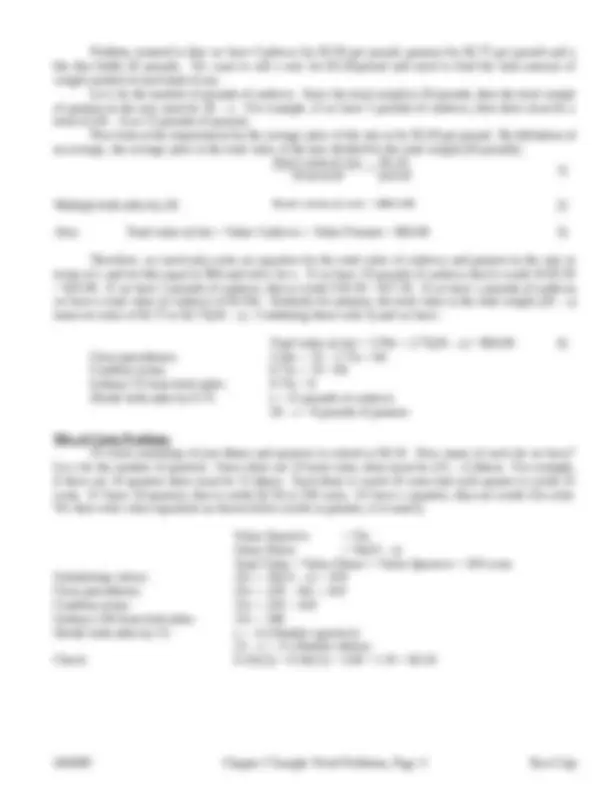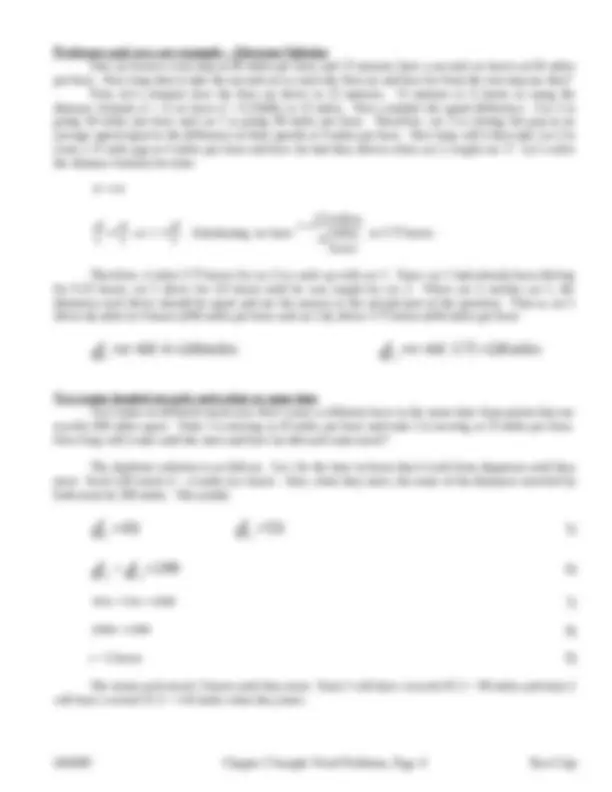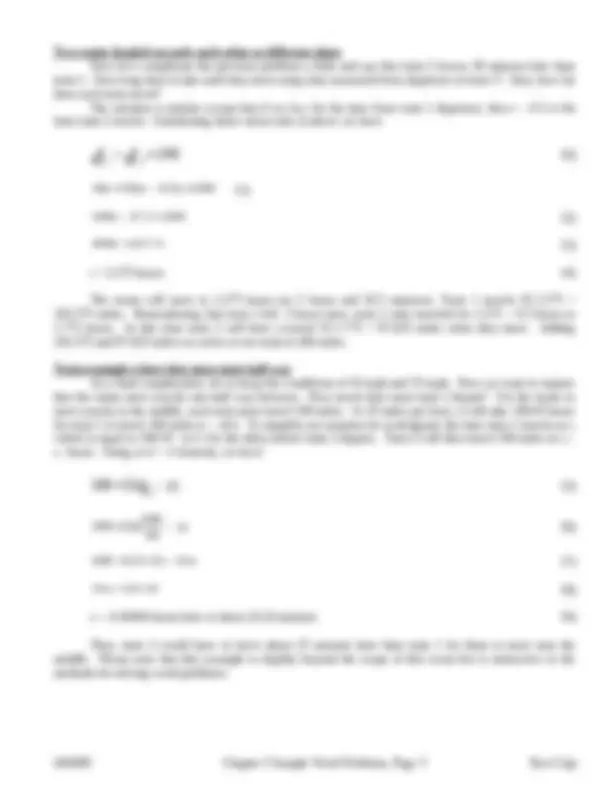





Study with the several resources on Docsity

Earn points by helping other students or get them with a premium plan


Prepare for your exams
Study with the several resources on Docsity

Earn points to download
Earn points by helping other students or get them with a premium plan
Community
Ask the community for help and clear up your study doubts
Discover the best universities in your country according to Docsity users
Free resources
Download our free guides on studying techniques, anxiety management strategies, and thesis advice from Docsity tutors
Solutions to word problems related to mixing peanuts and cashews in the nutty place to achieve an average price of $3.20 per pound. Tabular, graphical, and algebraic methods to find the optimal weight of each nut.
Typology: Exams
1 / 5

This page cannot be seen from the preview
Don't miss anything!




Tabular Solution to Nutty Place The Nutty Place desires to mix peanuts selling for $2.75 per pound with cashews selling for $3. per pound in a bin that holds 20 pounds. How many pounds of each nut must be mixed together to have an average price of $3.20 per pound? Since the bin holds exactly 20 pounds, we can assume that the sum of the weight of peanuts plus the weight of cashews must equal 20. Therefore, if there are 0 pounds of peanuts, then there must be 20 pounds of cashews. Similarly, if there are 20 pounds of peanuts, then there must be 0 pounds of cashews. For any other amount of cashews, we subtract the amount of cashews from 20 to compute the amount of peanuts. For example, if we have 15 pounds of cashews (4th^ line in table), then we must have 5 pounds of peanuts. Consider the following table. Column 1 is the weight of peanuts; Column 2 is the weight of cashews; Column 3 is the dollar value of peanuts; Column 4 is the dollar value of cashews; Column 5 is the total value of both cashews and peanuts; and Column 6 is the average price (Column 5 divided by the total of 20 pounds). In the table, we try various numbers until we find the result to be 8 pounds of peanuts and 12 pounds of cashews. The last line in the table represents the algebraic method of solving. Specifically, let C be the weight of cashews. Then the expression (20 – C) is the weight of the peanuts. Then we proceed to compute the value of each nut (Columns 3 and 4) and add them together to get the total value based on the variable C in column 5. We then divide that total by 20 pounds and set it equal to the desired average price of $3.20.
value Cashew value Total value Value per 20# 20 0 $55.00 $0.00 $55.00 $2. 0 20 $0.00 $70.00 $70.00 $3. 5 15 $13.75 $52.50 $66.25 $3. 6 14 $16.50 $49.00 $65.50 $3. 8 12 $22.00 $42.00 $64.00 $3. 20 – C C 2.75(20 – C ) 3.50 C 2.75 (20 – C) + 3.50 C $ 3. 20 20
Graphical Solution to Nutty Place Consider the graph at the right. The vertical scale is the average price of the mix and the horizontal scale is the amount of cashews mixed. When the horizontal scale is at 0, this means that we have 0 pounds of cashews and 20 pounds of peanuts. With all peanuts, the average price should be the price of peanuts or $2.75. When the horizontal scale is at 20, this means we have 20 pounds of cashews and 0 pounds of peanuts. With all cashews, the average price should be the price of the cashews or $3.50. Considering the algebraic solution above (see bottom line in chart), we see that this relationship is linear or a straight line as drawn in the figure. Therefore, to find the amount of cashews needed (the horizontal scale), move to 3.2 on the vertical scale (average price of $3.20) and move across to the line and then move down to the horizontal axis at 12 pounds of cashews. Now let us use the slope/intercept method to find the equation for this line. Then we can use the equation to find the number of pounds of cashews required to yield an average price of $3.20. The slope/intercept form is y = m x + b where y is the vertical scale and x is the horizontal scale. The y intercept is where the line crosses the vertical axis or $2.75. In other words, b is $2.75. Slope is defined as the vertical change divided by the horizontal change as follows: HorizontalChange pounds pounds pound Vertical Change m $
Professors and two cars example – Alternate Solution One car leaves a rest stop at 60 miles per hour and 15 minutes later a second car leaves at 64 miles per hour. How long does it take the second car to catch the first car and how far from the rest stop are they? First, let’s compute how the first car drove in 15 minutes. 15 minutes is ¼ hours so using the distance formula d = rt we have d = 0.25(60) or 15 miles. Now consider the speed difference. Car 2 is going 64 miles per hour and car 1 is going 60 miles per hour. Therefore, car 2 is closing the gap at an average speed equal to the difference in their speeds or 4 miles per hour. How long will it then take car 2 to close a 15 mile gap at 4 miles per hour and how far had they driven when car 2 caught car 1? Let’s solve the distance formula for time: d rt r rt r d (^) or r d t (^). Substituting we have hour miles miles t 4 15 or 3.75 hours. Therefore, it takes 3.75 hours for car 2 to catch up with car 1. Since car 1 had already been driving for 0.25 hours, car 1 drove for 4.0 hours until he was caught by car 2. When car 2 catches car 1, the distances each drove should be equal and are the answer to the second part of the question. That is, car 1 drives d 1 miles in 4 hours @60 miles per hour and car 2 d 2 drives 3.75 hours @64 miles per hour:
1
2
Two trains headed towards each other at same time Two trains on different tracks (we don’t want a collision) leave at the same time from points that are exactly 200 miles apart. Train 1 is moving at 45 miles per hour and train 2 is moving at 55 miles per hour. How long will it take until the meet and how far did each train travel? The algebraic solution is as follows. Let t be the time in hours that it took from departure until they meet. Each will travel d = rt miles in t hours. Also, when they meet, the some of the distances traveled by both must be 200 miles. This yields:
1
2
1 2
45 t 55 t (^200) 7) 100 t (^200) 8) t = 2 hours 9) The trains each travel 2 hours until they meet. Train 1 will have covered 45·2 = 90 miles and train 2 will have covered 55·2 = 110 miles when they meet.
Two trains headed towards each other at different times Now let’s complicate the previous problem a little and say that train 2 leaves 30 minutes later than train 1. How long does it take until they meet using time measured from departure of train 1? Also, how far does each train travel? The solution is similar except that if we let t be the time from train 1 departure, then t – 0.5 is the time train 2 travels. Substituting these values into 2) above we have:
1 2
45 t 55 ( t 0. 5 ) (^200) 11) 100 t 27. 5 (^200) 12) 100 t 227. (^5) 13) t = 2.275 hours. 14) The trains will meet in 2.275 hours (or 2 hours and 16.5 minutes). Train 1 travels 45·2.275 = 102.375 miles. Remembering that train 2 left .5 hours later, train 2 only traveled for 2.275 – 0.5 hours or 1.775 hours. In this time train 2 will have covered 55·1.775 = 97.625 miles when they meet. Adding 102.375 and 97.625 miles we arrive at our total of 200 miles. Train example where they must meet half way As a final complication, let us keep the conditions of 45 mph and 55 mph. Now we want to require that the trains meet exactly one-half way between. How much later must train 2 depart? For the trains to meet exactly in the middle, each train must travel 100 miles. At 45 miles per hour, it will take 100/45 hours for train 1 to travel 100 miles ( t = d/r ). To simplify our notation let us designate the time train 1 travels as t 1 which is equal to 100/45. Let x be the delay before train 2 departs. Train 2 will then travel 100 miles in x - t 1 hours. Using or d = rt formula, we have:
1
) 45 100 100 55 ( x 16) 100 122. 22 55 x 17) 55 x 22. (^22) 18) x = 0.40404 hours later or about 24.24 minutes. 19) Thus, train 2 would have to leave about 25 minutes later than train 1 for them to meet near the middle. Please note that this example is slightly beyond the scope of this exam but is instructive in the methods for solving word problems.